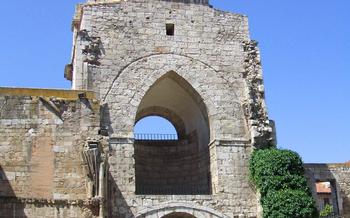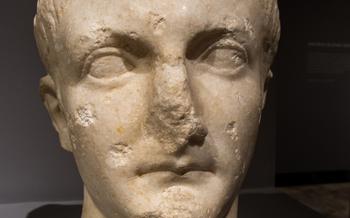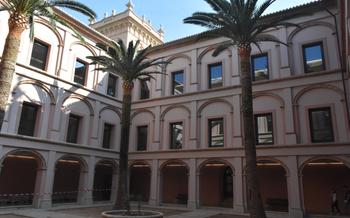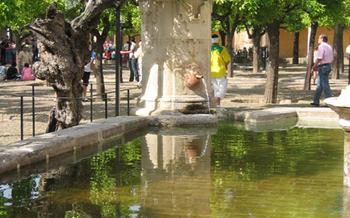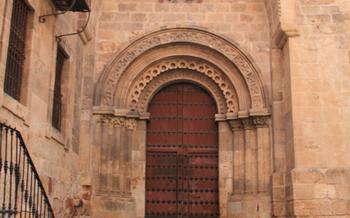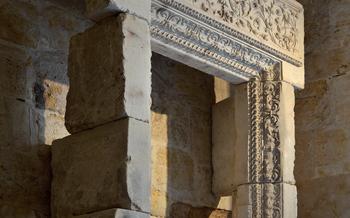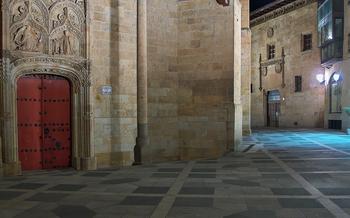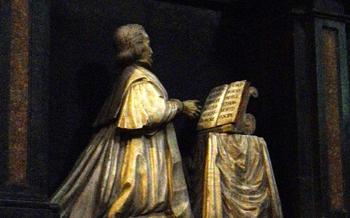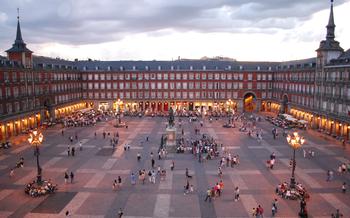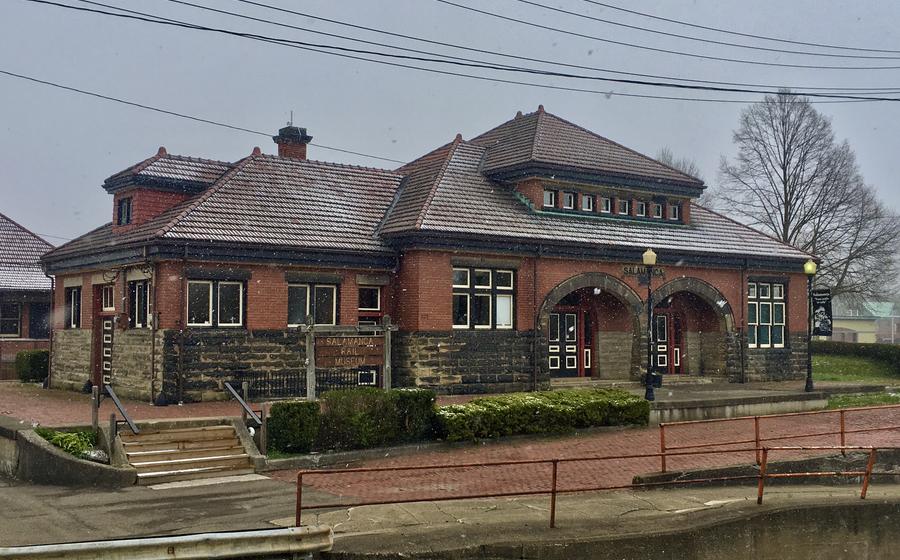
Salamanca Museum
- Salamanca Museum: A Historical and Cultural Gem
- Exploring the Museum's Collections
- The Romanesque and Gothic Art Galleries
- The Renaissance and Baroque Art Galleries
- The Collection of Spanish Painting
- The Sculpture Collection
- The Decorative Arts Collection
- The Numismatic Collection
- The Ethnographic Collection
- Temporary Exhibitions
- Educational Programs and Workshops
- Accessibility and Facilities
- Planning Your Visit
- Insider Tip: Hidden Gems
Salamanca Museum: A Historical and Cultural Gem
Nestled in the heart of Salamanca, Spain, the Salamanca Museum stands as a testament to the city's rich history and cultural heritage. Founded in 1902, the museum houses an impressive collection of over 30,000 artifacts, spanning from prehistoric times to the present day. Through its diverse exhibits, the museum offers a comprehensive journey through Spanish art, history, and culture, captivating visitors with its wealth of knowledge and stunning displays.
The museum's grand edifice, located on Plaza Mayor, is a work of art in itself. Designed by architect Joaquín de Vargas y Aguirre in a neoclassical style, the building features a majestic facade adorned with intricate carvings and sculptures. The interior, equally impressive, boasts spacious galleries, elegant staircases, and a central courtyard that floods the museum with natural light. Each room is carefully curated, creating an immersive experience that transports visitors back in time.
Exploring the Museum's Collections
The Salamanca Museum boasts a diverse collection of exhibits spanning various eras, from ancient Roman artifacts to contemporary artworks. Among the highlights of the collection are the Romanesque and Gothic sculptures, Renaissance and Baroque paintings, and a remarkable collection of Spanish painting.
The Romanesque and Gothic galleries showcase stunning sculptures and frescoes that exemplify the artistic styles of the Middle Ages. Notable pieces include the 12th-century Virgen de la Vega, a polychrome wooden sculpture of the Virgin Mary, and the 13th-century fresco cycle depicting the life of Christ in the Capilla de San Martín.
The Renaissance and Baroque galleries feature paintings, sculptures, and tapestries from the 15th to the 18th centuries. Highlights include El Greco's The Martyrdom of Saint Maurice, a masterpiece of Spanish Mannerism, and Francisco de Goya's The Third of May 1808, a powerful depiction of the Spanish resistance against Napoleon's invasion.
The collection of Spanish painting is particularly impressive, tracing the evolution of Spanish art from the Middle Ages to the 20th century. Works by renowned artists like El Greco, Goya, and Velázquez are on display, showcasing a variety of styles and techniques.
The Romanesque and Gothic Art Galleries
The Romanesque and Gothic periods were transformative eras for art in Spain. The Romanesque style, characterized by its rounded arches, thick walls, and intricate carvings, flourished in the 11th and 12th centuries. Notable pieces from this period include the "Cristo de las Batallas" (Christ of the Battles), a wooden sculpture depicting Jesus on the cross, and the "Virgen de la Vega" (Virgin of the Vega), a polychrome stone sculpture of the Virgin Mary.
The Gothic style, with its pointed arches, ribbed vaults, and stained-glass windows, emerged in the 13th century and dominated until the 15th century. Highlights of the Gothic collection include the "Retablo Mayor" (Main Altarpiece) of the Cathedral of Salamanca, a masterpiece of Gothic sculpture with intricate carvings depicting scenes from the Bible, and the "Virgen de la Antigua" (Virgin of the Old), a 13th-century wooden sculpture of the Virgin Mary known for its serene expression.
These artworks provide valuable insights into the religious, social, and cultural context of medieval Spain. They reflect the influence of the Catholic Church, the rise of urban centers, and the growing importance of art as a form of expression and devotion.
The Renaissance and Baroque Art Galleries
The Renaissance and Baroque periods marked a significant transformation in Spanish art, mirroring the broader cultural and intellectual shifts across Europe. The museum's galleries dedicated to these eras showcase a remarkable collection of paintings, sculptures, and tapestries that exemplify the artistic achievements of the time.
Among the highlights of the Renaissance collection are works by El Greco, a prominent artist known for his distinctive style characterized by elongated figures and vibrant colors. His masterpiece, "The Burial of Count Orgaz," is a must-see, depicting the legendary burial of a nobleman surrounded by a celestial host.
The Baroque period is represented by works from artists such as Francisco de Zurbarán and José de Ribera. Zurbarán's paintings often feature religious themes, characterized by their stark lighting and intense realism. His "Still Life with Oranges" is a striking example of his mastery of capturing the essence of everyday objects. Ribera, on the other hand, explored the darker side of human nature through his powerful and dramatic paintings, such as "The Martyrdom of Saint Bartholomew."
The influence of Italian and Flemish art is evident in many of the works displayed in these galleries. The Italian Renaissance, with its emphasis on humanism and classical ideals, had a profound impact on Spanish artists, who adopted elements of perspective, anatomy, and naturalism into their own works. The influence of Flemish painting, known for its intricate detail and realism, can be seen in the works of artists like Juan de Flandes and Pedro Berruguete.
The Collection of Spanish Painting
The Salamanca Museum boasts an impressive collection of Spanish paintings that spans from the Middle Ages to the 20th century. This section of the museum showcases the evolution of Spanish art, from the early religious works of the Romanesque period to the masterpieces of the Renaissance and Baroque eras, and the innovative styles of the modern period.
Among the highlights of the collection are works by renowned artists such as El Greco, Goya, and Velázquez. El Greco's "View of Toledo" captures the essence of the city with its elongated figures and vibrant colors. Goya's "The Third of May 1808" depicts the horrors of war with its powerful portrayal of the execution of Madrilenos by French soldiers. Velázquez's "Las Meninas" offers a glimpse into the life of the Spanish court with its complex composition and masterful use of light and shadow.
The collection of Spanish painting also includes works by other notable artists like Zurbarán, Murillo, and Ribera. Their paintings showcase the diverse styles and techniques that characterized Spanish art during the Golden Age. From the naturalism of Zurbarán to the emotional intensity of Murillo, and the tenebrism of Ribera, this section of the museum provides a comprehensive overview of the rich history of Spanish painting.
The Sculpture Collection
The Salamanca Museum boasts an impressive collection of sculptures that spans various periods and styles. One of the highlights is the "Entombment of Christ" by Alonso Berruguete, a masterpiece of Spanish Renaissance sculpture. The intricate details and expressive figures capture the emotions and drama of the biblical scene.
Another notable work is "The Virgin and Child" by Juan de Juni, a prominent sculptor of the Spanish Renaissance. This delicate and serene sculpture showcases Juni's skill in capturing the tenderness and grace of the Virgin Mary.
The museum also houses a significant collection of religious sculptures from the Middle Ages, including "The Crucifixion", a poignant depiction of Christ on the cross, and "The Virgin of the Assumption", a majestic representation of the Virgin Mary's ascension into heaven.
In addition to religious sculptures, the museum showcases a variety of secular works, such as "The Bullfighter" by Agustín Querol, a dynamic bronze sculpture that captures the essence of the Spanish tradition of bullfighting.
The iconography and symbolism of the sculptures provide insights into the religious beliefs, cultural values, and historical context of Spain. Whether you're an art enthusiast or simply curious about Spanish culture, the sculpture collection at the Salamanca Museum is not to be missed.
The Decorative Arts Collection
The Salamanca Museum boasts a remarkable collection of decorative arts that showcases Spanish craftsmanship and design from various periods. This collection encompasses exquisite furniture, ceramics, tapestries, and metalwork, each piece reflecting the cultural influences that shaped Spanish art and society.
Visitors can admire the intricate carvings and inlay work on wooden furniture, dating from the Renaissance to the Baroque periods. These pieces often feature elaborate designs incorporating mythological motifs, floral patterns, and biblical scenes. The collection also includes a range of ceramic ware, from glazed tiles to finely painted plates, showcasing the vibrant colors and traditional motifs of Spanish pottery.
Tapestries, woven with intricate scenes depicting historical events or religious narratives, offer a glimpse into the storytelling traditions of Spanish artisans. The museum's collection features tapestries from the 16th to the 18th centuries, demonstrating the evolution of weaving techniques and the influence of Flemish and French tapestry makers.
Metalwork, from delicate silver jewelry to ornate bronze sculptures, showcases the skill and artistry of Spanish metalworkers. Visitors can admire the intricate filigree work on jewelry, the repoussé and chasing techniques employed in metal sculptures, and the intricate designs of wrought-iron gates and railings.
The decorative arts collection at the Salamanca Museum provides a fascinating insight into the cultural influences, craftsmanship, and artistic traditions that have shaped Spanish society throughout history. These exquisite objects not only beautified the homes and palaces of the wealthy but also played a vital role in religious ceremonies and everyday life.
The Numismatic Collection
The Salamanca Museum boasts a remarkable numismatic collection, comprising coins and medals that span from ancient to modern times. This treasure trove offers a captivating journey through history, shedding light on economic and political developments through the lens of coinage.
Visitors can trace the evolution of currency in Spain, from the earliest Roman denarii to the modern euro, gaining insights into the rise and fall of empires, trade routes, and monetary systems. Rare and valuable pieces, such as gold coins from the Visigothic period or silver coins minted during the reign of the Catholic Monarchs, provide tangible connections to significant historical events.
The numismatic collection also highlights the artistic merit of coins and medals. Intricate designs, detailed engravings, and symbolic motifs showcase the skill and artistry of engravers and minters throughout the ages. Whether you're a history buff, an art enthusiast, or simply curious about the world of coins, this collection promises a fascinating and educational experience.
The Ethnographic Collection
The Salamanca Museum's ethnographic collection offers a fascinating glimpse into the diverse cultural traditions of Spain. This collection showcases a wide range of artifacts, including traditional costumes, tools, and everyday objects from different regions of the country.
Visitors can explore the rich cultural heritage of Spain through displays of regional dress, showcasing the unique textiles, embroidery, and styles that have been passed down through generations. Traditional tools and implements used in agriculture, fishing, and other trades provide insights into the daily lives and livelihoods of people in different parts of Spain.
The ethnographic collection also features a variety of household objects, such as furniture, ceramics, and kitchenware, which reflect the domestic life and customs of various Spanish regions. These artifacts offer a glimpse into the cultural influences that have shaped Spanish society, including Moorish, Jewish, and Christian influences.
By preserving and showcasing these cultural treasures, the Salamanca Museum plays a vital role in promoting awareness and appreciation for the diverse heritage of Spain. This collection serves as a reminder of the country's rich traditions and the importance of preserving cultural diversity for future generations.
Temporary Exhibitions
The Salamanca Museum hosts a variety of temporary exhibitions throughout the year, offering visitors a chance to explore specific artists, themes, or historical periods in greater depth. These exhibitions often feature works from the museum's own collection, as well as loans from other museums and institutions.
Temporary exhibitions add an element of dynamism and variety to the museum's offerings, allowing visitors to experience new and exciting works of art on a regular basis. They also provide an opportunity for the museum to collaborate with other cultural organizations and share its resources and expertise.
Whether you're interested in modern art, historical artifacts, or a particular artist, be sure to check the museum's website or social media channels to find out what temporary exhibitions are currently on display.
Educational Programs and Workshops
The Salamanca Museum offers a range of educational programs and workshops designed to engage visitors of all ages with its rich collection. Families and children can participate in interactive activities that foster creativity, critical thinking, and art appreciation. These programs often include hands-on workshops, storytelling sessions, and guided tours tailored to younger audiences, making the museum a vibrant and welcoming space for educational exploration.
The museum also caters to students and researchers with guided tours and lectures that delve deeper into the historical and artistic significance of its exhibits. These programs provide an opportunity for students to engage with experts in the field and gain a comprehensive understanding of the museum's collection.
By promoting art appreciation and cultural awareness through its educational offerings, the Salamanca Museum plays a vital role in fostering a lifelong love of learning and preserving Spain's rich cultural heritage.
Accessibility and Facilities
The Salamanca Museum is committed to providing a welcoming and accessible environment for all visitors. Wheelchair ramps and elevators are available throughout the museum, ensuring easy access to all levels and exhibitions. For visitors with visual impairments, audio guides are available in multiple languages, providing detailed descriptions of the artworks and their historical context. Multilingual tours are also offered for those who prefer a guided experience. To enhance the comfort of visitors, rest areas are located throughout the museum, and a cloakroom is available for storing personal belongings. After exploring the museum's treasures, visitors can relax and enjoy refreshments at the on-site cafeteria, offering a variety of snacks and beverages.
Planning Your Visit
To make the most of your visit to the Salamanca Museum, planning is key. Allocate at least two to three hours to thoroughly explore the extensive collection. The museum is open from Tuesday to Sunday, with varying hours, so check their website for specific information.
For a more personalized experience, consider booking a guided tour, available in multiple languages. These tours provide in-depth insights into the museum's highlights and the history behind the artworks.
To avoid crowds and ensure a seamless visit, consider purchasing your tickets online in advance. This allows you to choose a preferred time slot and skip the queues.
Combine your visit to the Salamanca Museum with other attractions in the vicinity. The museum is located in the heart of the historic city, surrounded by medieval architecture, charming plazas, and vibrant streets. Take some time to wander around, explore the old city walls, visit the University of Salamanca, or indulge in the local cuisine at one of the many tapas bars and restaurants.
Insider Tip: Hidden Gems
Beyond the main galleries and popular exhibits, the Salamanca Museum holds a treasure trove of hidden gems waiting to be discovered. Take a moment to venture off the beaten path and explore these lesser-known corners of the museum.
One such hidden gem is the Patio Chico, a charming inner courtyard tucked away amidst the museum's buildings. This tranquil oasis offers a moment of respite from the bustling crowds, where you can relax and soak in the serene atmosphere.
Another hidden gem is the Sala de las Pinturas Murales, a gallery dedicated to medieval frescoes. These beautifully preserved paintings depict scenes from religious and secular life, offering a glimpse into the artistic and cultural heritage of medieval Spain.
Don't miss the Sala de las Esculturas Policromadas, which houses a collection of polychrome sculptures from the Renaissance and Baroque periods. These exquisitely crafted works of art are characterized by their vibrant colors and intricate details, making them a feast for the eyes.
As you wander through the museum, keep your eyes peeled for other hidden surprises. Perhaps you'll stumble upon a forgotten masterpiece in a dimly lit corner or discover a secret passage leading to a hidden chamber. Embrace the spirit of exploration and let the museum's hidden gems unfold their secrets to you.
